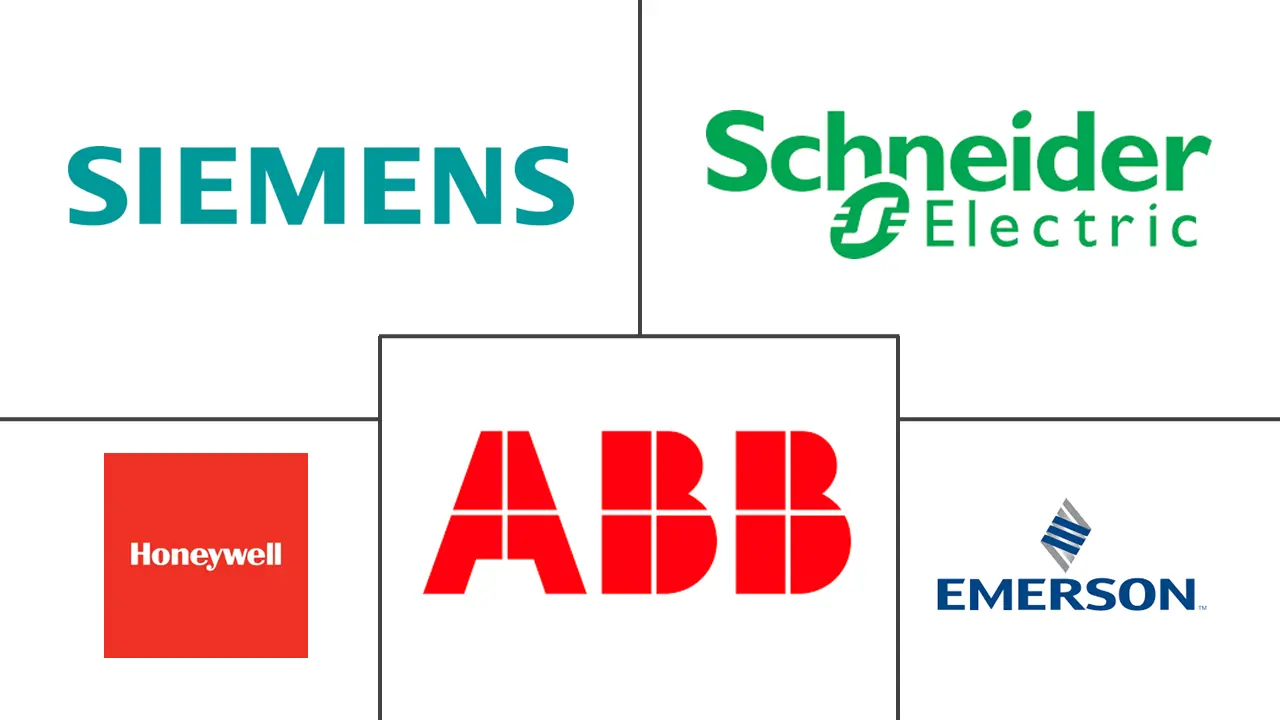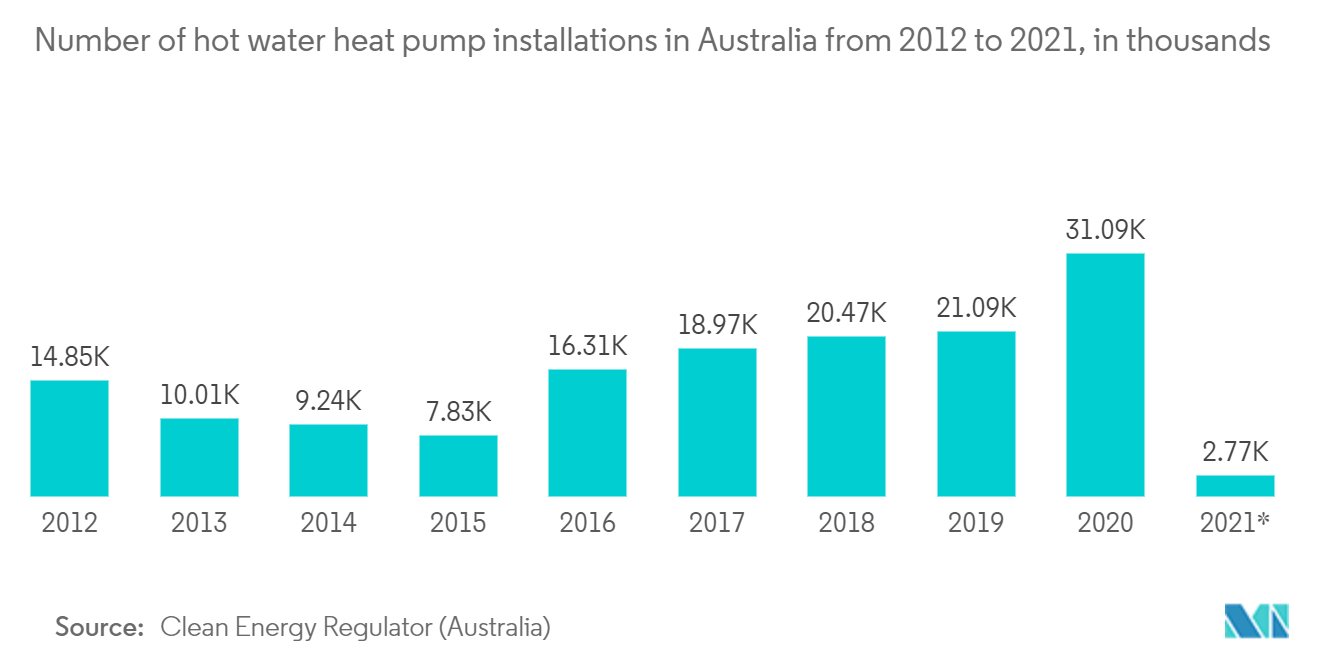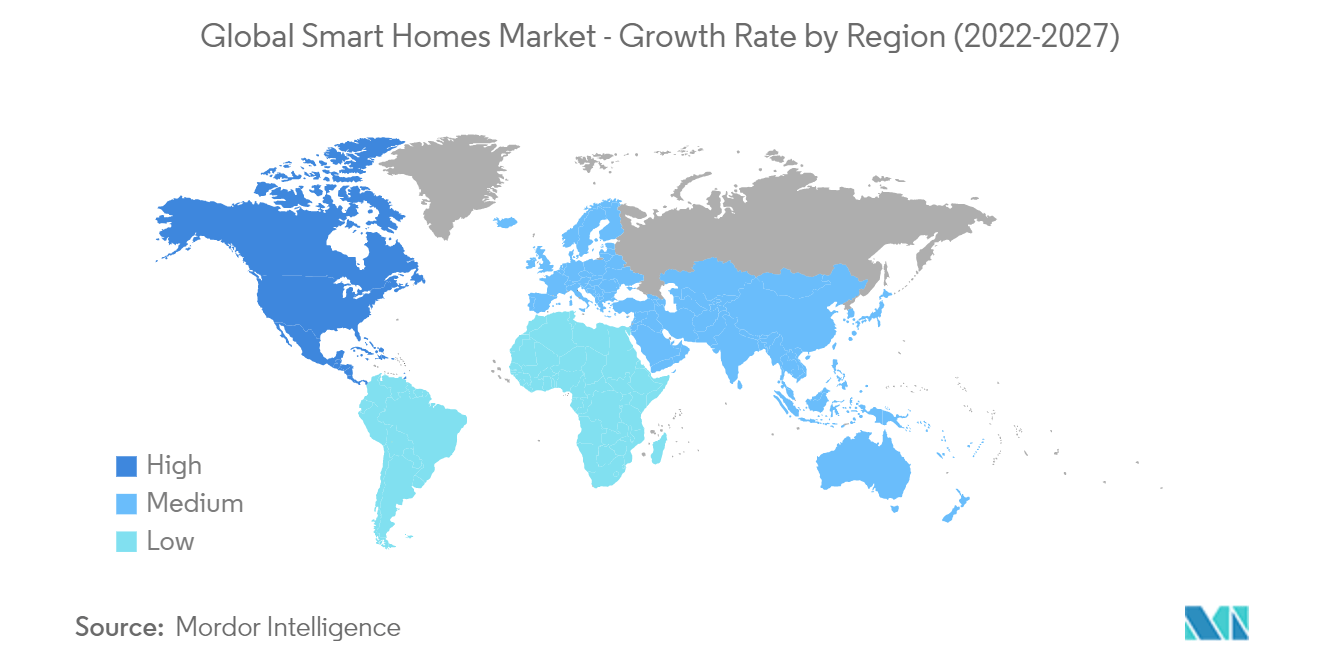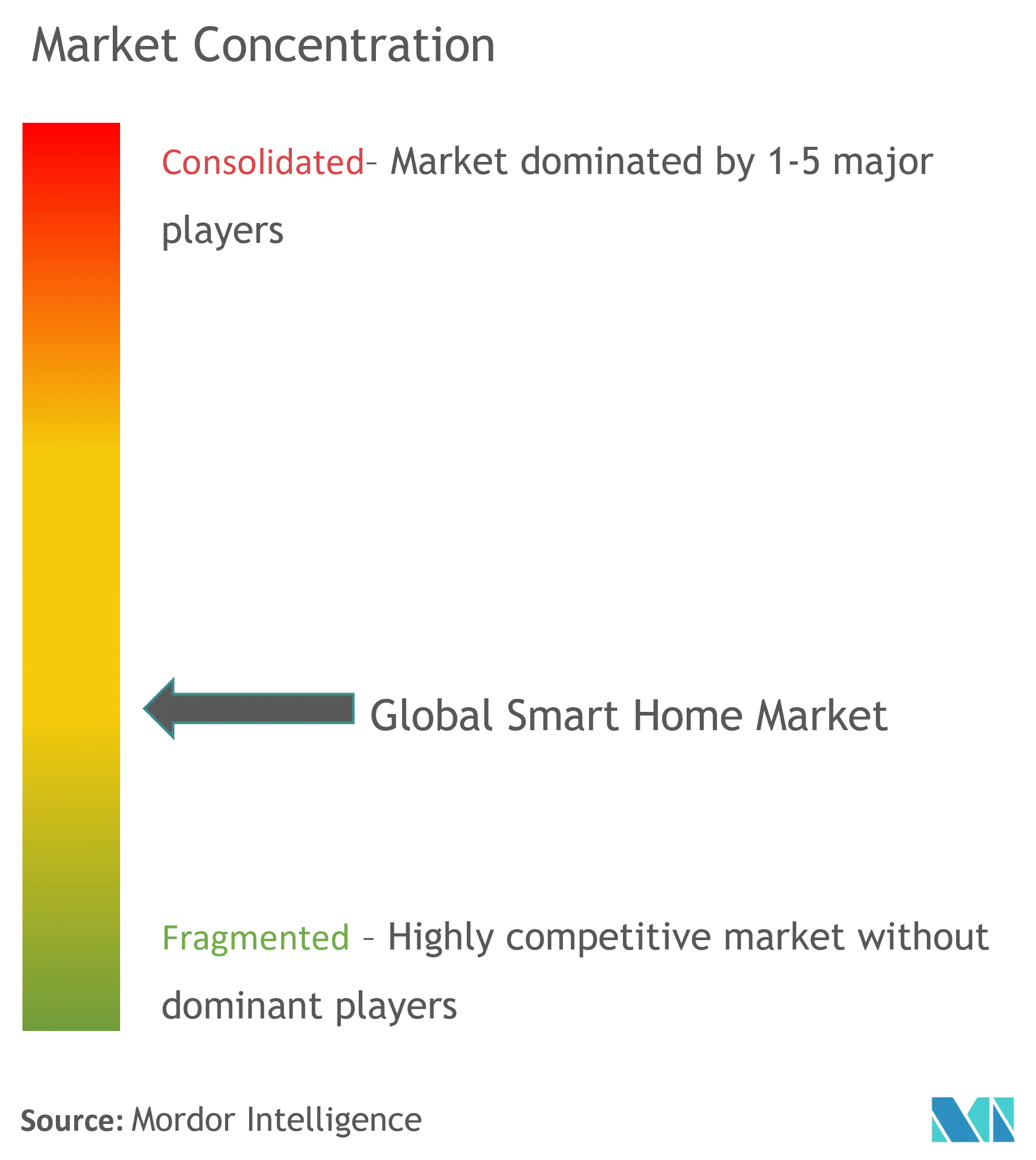Smart Home Market Size

| Study Period | 2019 - 2029 |
| Market Size (2024) | USD 120.10 Billion |
| Market Size (2029) | USD 370.95 Billion |
| CAGR (2024 - 2029) | 25.30 % |
| Fastest Growing Market | North America |
| Largest Market | North America |
Major Players
*Disclaimer: Major Players sorted in no particular order |
Smart Home Market Analysis
The Smart Homes Market size is estimated at USD 120.10 billion in 2024, and is expected to reach USD 370.95 billion by 2029, growing at a CAGR of 25.30% during the forecast period (2024-2029).
The Smart Homes Market size is estimated at USD 120.10 billion in 2024, and is expected to reach USD 370.95 billion by 2029, growing at a CAGR of 25.30% during the forecast period (2024-2029).
Across real estate companies and the architect ecosystem, the 'new normal' defined through the social distancing practice resulted in a requirement to go back to the redesign basics and reinvent the residential real estate products by factoring in new-age designing, efficiency, and innovation. As the redesigning happens, the need for a totally new set of amenities has resurfaced and gained prominence. What the customer will need in the 'new normal' has undergone a revolution in the crisis triggered by the COVID-19 pandemic, and it is leading to a paradigm shift in residential spaces.
- Home automation and smart homes are two ambiguous terms used in reference to a wide range of monitoring solutions, controlling, and automating functions in a home. Unlike simple home automation solutions (which could range from motor-operated garage doors to automated security systems), smart home systems require a web portal or a smartphone application as a user interface to interact with an automated system.
- Globally, the increasing importance of the need to counter security issues is anticipated to fuel the demand for smart and connected homes over the forecast period. Moreover, innovative wireless technologies, including security and access regulators, entertainment controls, and HVAC controllers, are expected to foster market growth.
- The companies are continuously investing in new product designs. For example, Google's Nest smart-home division recently introduced a new smart thermostat. The new Nest Thermostat is a simpler model than the Nest Learning Thermostat or Nest Thermostat E and is offered at a lower price of USD 129.99, accounting for a difference of USD 40 less than the Nest E and USD 120 less than the top-of-the-line third-generation Nest Learning Thermostat. It was made available to pre-order immediately.
- T-Mobile also announced that it will be launching a 5G-based home network by 2024. The aim is to extend coverage to previously underserved rural areas across the United States. It is currently offering a trial version of the service on its 4G LTE network to a select a number of T-Mobile customers.
Smart Home Market Trends
HVAC Systems are Among the Most Significant Contributors to the Market
According to a report from the US National Academy of Sciences (NAS), the first decade of the 21st century was 0.8°C (1.4°F) warmer than the first decade of the 20th century. The variation in climatic changes has led to the increasing demand for electrical cooling systems in summers and, simultaneously, for natural gas, heating oil, wood, and electrical heating systems in winters.
With the advent of new government regulations regarding efficiency, the usage of HVAC systems is expected to rise. This has opened a gateway to the smart HVAC control systems for the most advanced heating and air conditioning units in buildings. Thus, the already existing HVAC equipment would have to be either replaced or retrofitted to adjust the energy efficiency as per the government standards. This would drive the need for HVAC retrofitting, thereby augmenting the overall market's growth positively.
Proper airflow will also help in humidity control. If the buildings maintain a relative humidity of 40%-60% inside, this will decrease the virus's ability to infect occupants. If the HVAC system incorporates makeup air, it also will increase ventilation, thus creating an even more healthy environment. In multiple commercial HVAC systems, filters are measured in MERV (minimum efficiency reporting values).
Moreover, reducing IoT sensor costs is also expected to result in OEMs offering products for a more competitive and lower price, which could indirectly impact the HVAC equipment market. Green HVAC systems are being developed to bring down costs and improve energy efficiency.
Starting from 2023, all new residential central air-source heat pump systems sold in the United States are expected to meet new minimum energy efficiency regulations and standards. The latest minimum energy efficiency standards for these equipment types went into effect in 2015. The new regulations require an increase in the heating efficiency of all air-source heat pumps.

North America Holds the Major Share of the Market
Smart homes are on the rise, with nearly 30 million US households projected to add smart home technology in the near future. The products consumers are looking to add to their homes include connected cameras (highest demand), video doorbells (second-highest demand), connected light bulbs, smart locks, and smart speakers.
According to the US Department of Energy, the buildings sector accounted for about 76% of the electricity used, resulting in a considerable amount of associated greenhouse gas (GHG) emissions, thereby making it necessary to reduce energy consumption in buildings to comply with the national energy and environmental challenges and decrease costs to building owners and tenants.
According to the New York State Energy Research and Development Authority (NYSERDA), enabling smart technologies and real-time energy management systems can decrease costs by an average of 15% and improve the bottom line by creating an ecosystem that reduces energy waste.
Moreover, with the COVID-19 impact, multiple energy management software providers extend their services beyond energy management systems by building health assessment solutions. One such example is Honeywell, which launched an integrated set of solutions to help building owners improve the health of their building environments, along with energy efficiency. These solutions further help building owners operate more cleanly and safely and also comply with social distancing policies.
Other innovations have also led the market in the region. For instance, in February 2021, Aspinity announced the availability of its Acoustic Event Detection Kit (EVK1) for battery-operated, smart home devices that are always listening for acoustic triggers, such as window glass breaks or other acoustic events. The kit features the company's analogML core, a fully analog machine learning processor that promotes system power efficiency by identifying specific acoustic events before data digitization.

Smart Home Industry Overview
The smart homes market is highly competitive and consists of several major players. In terms of market share, a few of the major players currently dominate the market. The market appears to be moderately fragmented. These major players with a prominent share are focusing on expanding their customer base across foreign countries. These companies are leveraging on strategic collaborative initiatives to increase their market shares and profitability.
- January 2021 - Samsung launched large-capacity Variable Refrigerant Flow (VRF) air conditioning systems in India that can be installed in just 0.5 sq. m of space in premium apartments, villas, bungalows, and houses as commercial and retail establishments. The Wi-Fi-enabled DVM S Eco series offers smart features, such as voice control and a connected home experience, using the SmartThings app on any smartphone. Each indoor unit can be controlled separately for enhanced convenience. To offer energy efficiency, current, daily, weekly, or even monthly energy consumption can be monitored on the basis of the usage of outdoor units. DVM S Eco series provides ease of installation, wherein up to 16 indoor units can be set up at once.
- March 2021 - Emerson and Ameren Missouri announced a partnership to give away Emerson's Sensi smart thermostats to Ameren Missouri customers. Through instant discounts and participation in the Peak Time Savings program, Ameren Missouri customers will be getting Emerson's Sensi smart thermostat at no cost other than the required sales tax. Participants can significantly save on their bills while using advanced technology that will enable them to control their thermostats from anywhere with a smartphone.
Smart Home Market Leaders
-
ABB Ltd.
-
Schneider Electric SE
-
Honeywell International Inc.
-
Emerson Electric Co.
-
Siemens AG
*Disclaimer: Major Players sorted in no particular order

Smart Home Market News
- In August 2021, ABB India introduced a new switch line. ISI-certified Millenium and Zenit switches provide consumers with control, functionality, and comfort in smart buildings and premises that can be readily upgraded with the most up-to-date smart home automation systems. Customers may move from traditional lighting to an eco-friendly intelligent alternative with these switches designed for both residences and commercial facilities.
- In August 2021, during the 2021 CEDIA Expo, Schneider Electric planned to unveil the Square DTM X and XD Series linked wiring devices to the general public for the first time. This whole series of linked light switches, dimmers, and outlets will automate lighting in the home, enable discrete power control, and provide energy usage at the plug level to help homeowners save money on their energy bills. The X Series has a lot of features, such as simple installation, a new modern design, and smart home connectivity.
Smart Home Market Report - Table of Contents
1. INTRODUCTION
- 1.1 Study Assumptions and Market Definition
- 1.2 Scope of the Study
2. RESEARCH METHODOLOGY
3. EXECUTIVE SUMMARY
4. MARKET INSIGHTS
- 4.1 Market Overview
-
4.2 Industry Attractiveness - Porter's Five Forces Analysis
- 4.2.1 Bargaining Power of Suppliers
- 4.2.2 Bargaining Power of Buyers
- 4.2.3 Threat of New Entrants
- 4.2.4 Intensity of Competitive Rivalry
- 4.2.5 Threat of Substitute Products
- 4.3 Assessment of Impact of COVID-19 on the Market
-
4.4 Technology Snapshot
- 4.4.1 Major Communication and Connectivity Technologies used in Smart Homes (Bluetooth, Wi-Fi, ZigBee, and Z-wave, Among Others)
- 4.4.2 Key Industry Standards and Policies
5. MARKET DYNAMICS
-
5.1 Market Drivers
- 5.1.1 Increasing Demand for Energy-efficient Solutions
- 5.1.2 Growing Need for Automation of Security Systems
-
5.2 Market Restraints
- 5.2.1 High Installation and Replacement Costs
6. MARKET SEGMENTATION
-
6.1 Product
- 6.1.1 Comfort and Lighting
- 6.1.2 Control and Connectivity
- 6.1.3 Energy Management
- 6.1.4 Home Entertainment
- 6.1.5 Security
- 6.1.6 Smart Appliances
-
6.2 Geography
- 6.2.1 North America
- 6.2.1.1 United States
- 6.2.1.2 Canada
- 6.2.2 Europe
- 6.2.2.1 Germany
- 6.2.2.2 United Kingdom
- 6.2.2.3 Denmark
- 6.2.2.4 Norway
- 6.2.2.5 Sweden
- 6.2.2.6 Rest of Europe
- 6.2.3 Asia-Pacific
- 6.2.3.1 China
- 6.2.3.2 Japan
- 6.2.3.3 India
- 6.2.3.4 Rest of Asia-Pacific
- 6.2.4 Latin America
- 6.2.4.1 Brazil
- 6.2.4.2 Mexico
- 6.2.4.3 Rest of Latin America
- 6.2.5 Middle-East and Africa
- 6.2.5.1 United Arab Emirates
- 6.2.5.2 Saudi Arabia
- 6.2.5.3 South Africa
- 6.2.5.4 Rest of Middle-East and Africa
7. COMPETITIVE LANDSCAPE
-
7.1 Company Profiles
- 7.1.1 ABB Ltd
- 7.1.2 Schneider Electric SE
- 7.1.3 Honeywell International Inc.
- 7.1.4 Emerson Electric Co.
- 7.1.5 Siemens AG
- 7.1.6 LG Electronics Inc.
- 7.1.7 Cisco Systems Inc.
- 7.1.8 Google Inc.
- 7.1.9 Microsoft Corporation
- 7.1.10 General Electric Company
- 7.1.11 IBM Corporation
- 7.1.12 Legrand SA
- 7.1.13 Lutron Electronics Co. Inc.
- 7.1.14 United Technologies Corporation
- 7.1.15 Smarthome Inc.
- 7.1.16 Control4 Corporation
- 7.1.17 Shenzhen Zhuohao Intelligent Electronic Development Co. Ltd (ACTOP)
- *List Not Exhaustive
8. INVESTMENT ANALYSIS
9. FUTURE OF THE MARKET
** Subject To AvailablitySmart Home Industry Segmentation
Smart home devices are suitable for a home setup where devices can be automatically controlled distantly from any Internet-connected place in the world, using a mobile or other networked devices. A smart home has its devices connected through the Internet, and the customer can regulate functions, such as security access to the house, temperature, lighting, and home theater. The smart homes market is segmented by product type (comfort and lighting, control and connectivity, energy management, home entertainment, security, and smart appliances) and geography.
| Product | Comfort and Lighting | |
| Control and Connectivity | ||
| Energy Management | ||
| Home Entertainment | ||
| Security | ||
| Smart Appliances | ||
| Geography | North America | United States |
| Canada | ||
| Geography | Europe | Germany |
| United Kingdom | ||
| Denmark | ||
| Norway | ||
| Sweden | ||
| Rest of Europe | ||
| Geography | Asia-Pacific | China |
| Japan | ||
| India | ||
| Rest of Asia-Pacific | ||
| Geography | Latin America | Brazil |
| Mexico | ||
| Rest of Latin America | ||
| Geography | Middle-East and Africa | United Arab Emirates |
| Saudi Arabia | ||
| South Africa | ||
| Rest of Middle-East and Africa |
Smart Home Market Research FAQs
How big is the Smart Homes Market?
The Smart Homes Market size is expected to reach USD 120.10 billion in 2024 and grow at a CAGR of 25.30% to reach USD 370.95 billion by 2029.
What is the current Smart Homes Market size?
In 2024, the Smart Homes Market size is expected to reach USD 120.10 billion.
Who are the key players in Smart Homes Market?
ABB Ltd., Schneider Electric SE, Honeywell International Inc., Emerson Electric Co. and Siemens AG are the major companies operating in the Smart Homes Market.
Which is the fastest growing region in Smart Homes Market?
North America is estimated to grow at the highest CAGR over the forecast period (2024-2029).
Which region has the biggest share in Smart Homes Market?
In 2024, the North America accounts for the largest market share in Smart Homes Market.
What years does this Smart Homes Market cover, and what was the market size in 2023?
In 2023, the Smart Homes Market size was estimated at USD 89.71 billion. The report covers the Smart Homes Market historical market size for years: 2019, 2020, 2021, 2022 and 2023. The report also forecasts the Smart Homes Market size for years: 2024, 2025, 2026, 2027, 2028 and 2029.
What are the key factors driving Global Smart Home Market growth?
The key factors driving the Smart Home Market are: a) Increasing Demand for Energy-efficient Solutions b) Growing Need for Automation of Security Systems
Which segment is the fastest-growing in Smart Home Market?
Smart security is the fastest-growing segment due to increasing security concerns and remote access features.
Smart Home Industry Report
The global smart home market is surging, led by consumer demands for safety, security, and energy efficiency. The integration of AI and increased internet accessibility are propelling smart device adoption, with smart security and kitchens poised for high growth. Data connectivity in lighting offers innovation opportunities, though challenges like device compatibility may affect growth. The inclusion of proactive software promises insights for energy use. Regionally, North America leads, but Asia Pacific's industrial advancements position it for rapid growth, especially in healthcare and automotive manufacturing. Despite obstacles, the 3D printing and smart home sectors show strong growth prospects, supported by technological innovations and strategic partnerships. Statistics for the Global Smart Home Market share, size and revenue growth rate, created by Mordor Intelligence™ Industry Reports. Smart Home analysis includes a market forecast outlook and historical overview. Get a sample of this industry analysis as a free report PDF download.



